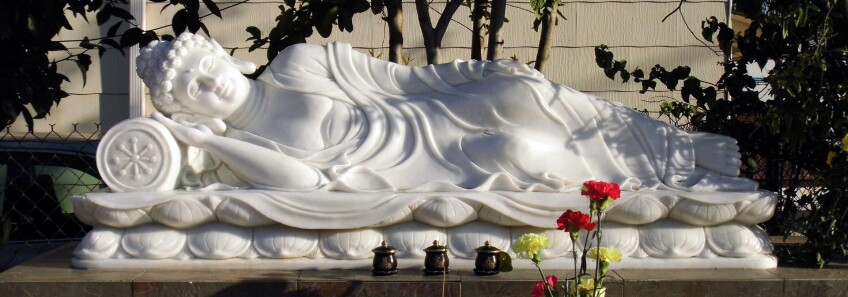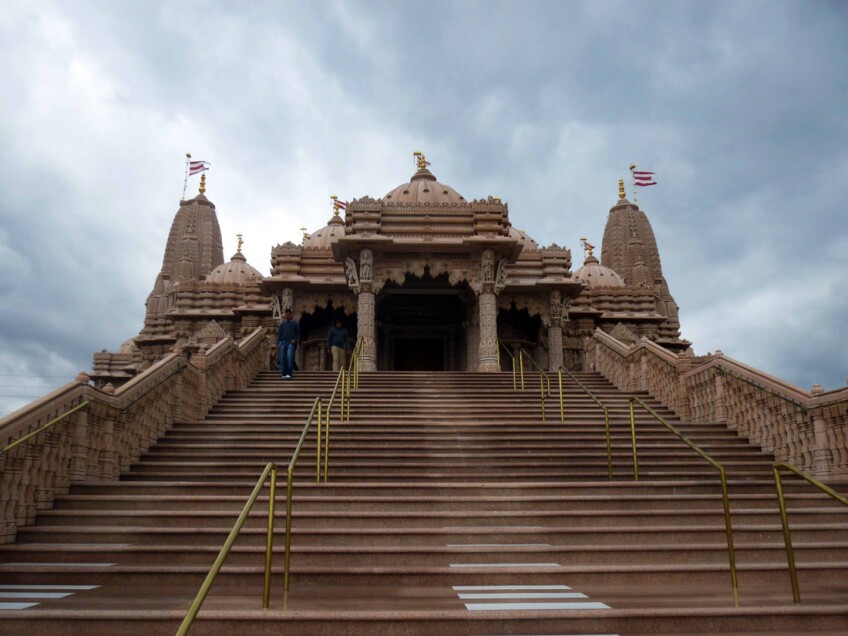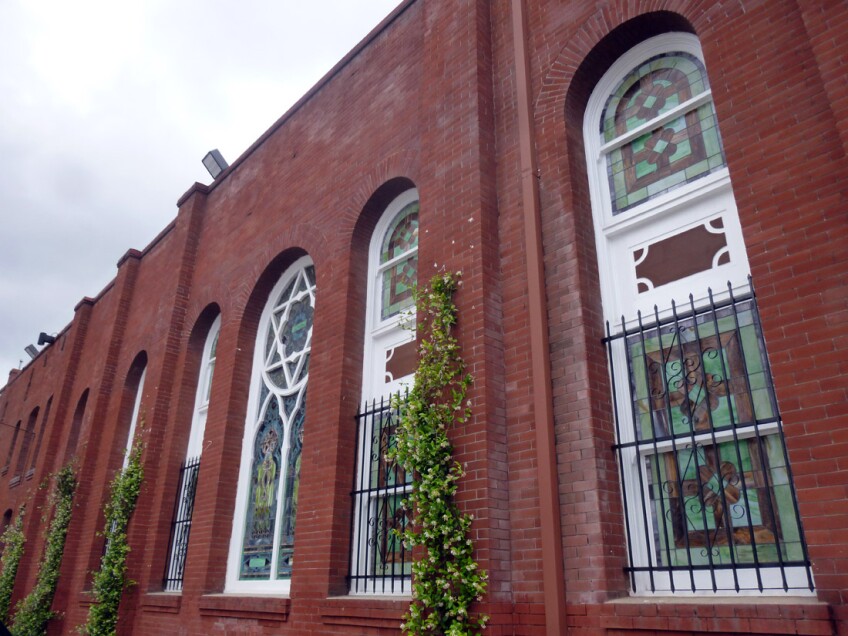Five Great L.A. Temples That Are Open to the Public

We all have our temples. They may be masquerading as movie palaces or nightclubs or “cathedrals of commerce,” but people travel far and wide to worship at them all the same.
There’s a reason why the “Temple of Finance” architectural style that marked so many of our (now defunct) banks drew so many money-worshipping financiers and debtors alike. At one point or another, we all need a place to go for a little ritual to express a little devotion to whatever it is we’ve deified.
In Los Angeles, of course, there are the sacred temples that became famous — or infamous — for reasons that transcended religion (namely, Angelus Temple and the antics of evangelist and alleged kidnapee Sister Aimee Semple McPherson). But beyond those, other places of worship are a little less obvious — and sometimes even hidden in plain view.
Although they may not feature flashy gimmicks or celebrity clerics, many of them practice an open door policy for their local communities and beyond — without regard to your particular background or proclivities.
So, whether you have a difference in faith – or an indifference to faith — take off your shoes, set aside your fears and give yourself over to these five great temples and their (sometimes rather theatrical) traditions.
1. BAPS Shri Swaminarayan Mandir, Chino Hills
If you’re driving on the 71 Freeway in the San Gabriel Valley, you can’t miss the BAPS Shri Swaminarayan Mandir. But when you see it, you might not know that you’re looking at an architecturally fascinating Hindu temple. Because it was only just built in 2002 (much more recently than, say, the 1981 Malibu Temple in Calabasas), it can take advantage of modern technology and energy efficiency, fusing traditional Indian architecture with modern construction techniques. Forty base isolators allow for lateral movement during an earthquake, so the upper portion of the Mandir will "float" above the moving ground and foundation. It's also powered by solar energy. The Mandir’s hand-carved exterior of imported Indian pink sandstone is impressive and elaborate, but it’s the interior that’s absolutely jaw-dropping, with hand-carved Italian marble and shrines to various deities and gurus (Murti) like Shri Ghanshyam Maharaj, Shri Nilkanth Varni and Brahmaswarup Shastriji Maharaj. Photography isn’t allowed inside, which is a mixed blessing. That means you have to go see it in person — and that your visit won’t be disturbed by anyone taking a selfie. Make your first stop at the visitor's center (the Haveli), with its intricate woodcarvings, which was completed in 2007. Tell everyone you meet that it’s your first time and they’ll welcome you and offer to show you around.


2. International Society for Krishna Consciousness of Los Angeles, Culver City
The Hare Krishna Cultural Center just north of Culver City isn’t just a place of worship. It’s actually a temple, a museum and a restaurant — and, to get the full experience, you’ve got to hit all three of them during your visit. First, visit the temple room during regular services (the Sunday Feast arati is highly recommended) or one of the feast celebrations. Get a good look at the ornate altar that features icons of deities like Lord Jagannatha, Lord Baladeva and Lady Subhadra (among others), which are dressed and decorated differently throughout the month depending on the day and time of day. (You can check on what they’re wearing at any given time by watching the temples livestream.) Join in as worshippers chant Hare Krishna, Hare Rama and dance, making offerings of a water-filled conch shell, flowers, tail fans and other offerings. A lamp of flaming ghee (clarified butter made from the milk of the sacred cow) is presented to Srila Prabhupada, founder of the Hare Krishna Movement, and passed around the room. Sniff the flowers that are passed to you and accept the sprinkle of holy water that’s offered to you, and then head next door to learn more about the spiritual teachings spoken by Lord Krishna at the Bhagavad-Gita Museum. Its 11 dioramas feature figures of the sacred text (like Arjuna the warrior and Krishna, his chariot driver) that were made out of clay and straw in the 1970s. Taking on many different forms (sometimes terrifyingly so), Krishna teaches that our souls are trapped in an endless ocean of birth and death. When you’ve finished moving through the animatronic spectacle, head downstairs to Govinda’s to partake in its vegan-friendly buffet and contemplate your past lives and future incarnations.


3. Lu Mountain Temple, Rosemead
Tucked away in a residential neighborhood, and distinguishable not by its architecture but by its statuary out front, Lu Mountain Temple is a good place to visit if you want meditate, pray and eradicate your karmic obstructions while surrounded by walls covered in golden Buddhas. In addition to mantra recitations, you can also attend lectures given by Dharma Master YongHua (who has a surprisingly good social media presence). But the real draw to Lu Mountain — particularly for those who don’t practice Buddhism or really any other discipline — is The 10,000 Relics Collection. The relics include Buddha's finger, which was relocated to Rosemead two years ago, when it joined the sparkly tooth of Buddha as part of the largest collection of Buddhist relics in the U.S. But these are no ordinary preserved body parts of any ol’ dead saint or prophet. Many of them are glittering crystals that were salvaged from the ashes of an enlightened sage who'd been cremated. Some of them are gem-like formations that grew on top of body parts like teeth and fingers — and when they were removed and placed into a separate container, they kept growing. There’s even a hair that supposedly moves. These spontaneously-growing, crystalized formations are called "shariras" (or, in Sanskrit, śarīrāḥ) — and some of them are even known to emanate a particular aroma (which, allegedly, is more floral than fleshy). Since the collection was first donated to Lu Mountain Temple in 2013, other donations have expanded it — and, year after year, the demand to witness it also grows. Right now you can only see them for a week out of the year during Lunar New Year celebrations, but the temple is raising funds to make the relics more accessible on a more permanent basis in a proper shrine.


4. Wilshire Boulevard Temple, Koreatown
You can't really talk about the history of Hollywood without considering Judaism. And it would be tough to consider the Jewish history of L.A. without including Hollywood. AndWilshire Temple — in what was once the western boundary of the City of Los Angeles but now smack dab in the middle of K-Town — is the house that Hollywood built. Although architect Abram M. Edelman designed it, it was funded by contributions and donations from all the major film impresarios of the 1920s. Hollywood art director and production designer Hugo Ballin painted its Jewish history murals, courtesy of the Warner Brothers. Sid Grauman, Louis B. Mayer, Carl Laemmle and Irving Thalberg of MGM all donated other aspects of the temple as well — the latter of whom was responsible for the sanctuary's 100 foot octagonal domed ceiling, with its oculus lit in a midnight blue and inscribed with a Jewish prayer from the Torah. Byzantine and Moorish in design, this is the third home of the Congregation B’nai B’rith (founded in 1862), making it the oldest synagogue in the L.A. area. But it feels very much like a theater — as was the wish of Rabbi Edgar F. Magnin, who chose its location to be on Wilshire (a.k.a. "The Fifth Avenue of the West") and who had so many Hollywood friends that they knew him as the "Rabbi to the Stars." You can attend services to see other aspects of the temple’s recently restored interior (like the stained glass rose window depicting the twelve tribes of Israel), or you can make an appointment to take a tour.


5. Pico-Union Project, Pico-Union
Sometimes, a building is just a building. What matters is what you do with it. Case in point: Sinai Temple, L.A.'s first Conservative synagogue, built in 1909. The former temple has now been turned into the interfaith headquarters for the Pico-Union Project, founded in 2013 by Jewish musician Craig Taubman and dedicated to the Jewish principle of "love your neighbor as yourself" (which Christians will recognize as "love thy neighbor"). The temple had actually been operating as the Welsh Presbyterian Church since 1925, though much of its original Jewish and architectural features were retained and have been maintained. Now, the sanctuary has essentially been converted into a theater, welcoming performances and parties from all cultures and religious traditions. In fact, the organizers insist that each evening's program be culturally diverse — from Yiddish music to comedy and electronic dance music and DJs. This former Christian church and Jewish synagogue now also welcomes The Women's Mosque of America, which had a hard time finding a place for worship before settling here. In fact, it actually houses five different worship communities, which makes sense considering its neighbors are largely immigrants from Central America, Mexico, Cuba and Korea. All are welcome — yes, even you.









